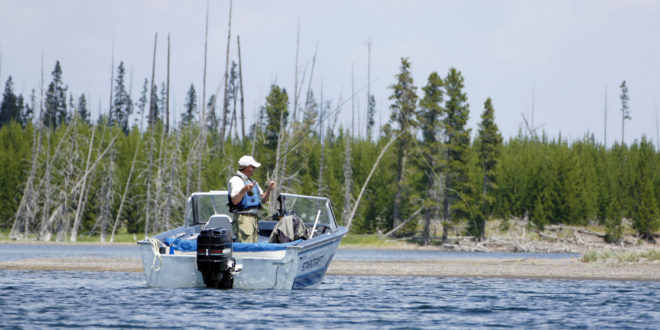Yellowstone officials are ramping up their efforts to combat aquatic invasive species such as mussels—by modifying their boat ramps.
Boaters coming to Yellowstone National Park this summer will find “movable barriers” in front of the boat launches onto Yellowstone Lake in Bridge Bay and Grant Village. Barriers will also be installed at the Lewis Lake ramp.
The news comes a week after Yellowstone officials announced stricter watercraft guidelines, including more stringent inspections and cleaning methods.
According to the Jackson Hole News and Guide, the barriers, like the new watercraft rules, are in response to reports of zebra mussels in Montana:
“We’ve had positive hits in the Missouri [River], in the Great Falls area,” [Yellowstone fisheries supervisor Todd] Koel said during an April meeting. “For us, that’s local. It’s a few hours away. We’re pretty worried about it.
“We’re trying to keep it out of the Columbia River Basin, too,” he said. “If they were introduced to Yellowstone Lake, Lewis Lake is just miles away. We don’t want to be known as the park that allowed zebra mussels to enter the Columbia Basin.”
Updated regulations and management plans for aquatic invasive species control in Yellowstone were announced last week.
The intention of the boat launch barriers is to prevent uninspected boats from entering Yellowstone lakes in the early morning and evening hours — times when check stations and entry points are not staffed.
In the event of a non-native mussel detection anywhere in the Greater Yellowstone Ecosystem, officials will now consider a temporary closure of all Yellowstone waters to watercraft, both motorized and hand-propelled. A rapid response plan is also in the works, as is a science panel that will evaluate aquatic invasive prevention and management.
Yellowstone rules require that all watercraft — power boats, sailboats, canoes, kayaks and angler float tubes — be inspected prior to hitting the water. Permits and inspections are available seven days a week between 8 a.m. and 4:30 p.m. at various entry points and visitor centers.
Boater registration data suggests that the majority of vessels using Yellowstone waters are coming from Montana, Wyoming and Idaho, where aquatic invasive species are relatively under control. But a fraction of the approximately 4,000 vessels a year are from farther reaches.
“Several [boats] come from the South, where there are definitely a lot of AIS threats,” Koel said. “There were 40 boats from Florida last year that came to Yellowstone.”
In addition to barriers, Koel says the park needs more power washers to ensure boats are fully cleaned before deploying in Yellowstone. Currently, the park has two Hotsy high-temperature pressure washers installed to clean boats before they head into the park. They’re installed at the South Entrance and in Bridge Bay. According to Koel, however, the park needs about six to keep up with demand and ensure all boats are being scrubbed of aquatic invasive species.
Yellowstone’s fishery department, of course, has put intense focus on aquatic invasive species for years. The mussel threat is merely the latest to come under their purview. Since the mid-1990s, fishery employees have been working to cull lake trout from Yellowstone Lake, which have displaced the native cutthroat trout. The results, on the whole, have been encouraging in recent years.
 Yellowstone Insider Your Complete Guide to America's First National Park
Yellowstone Insider Your Complete Guide to America's First National Park





